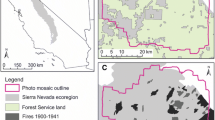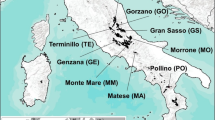Abstract
Landscape structure in the Eastern US experienced great changes in the last century with the expansion of forest cover into abandoned agricultural land and the clearing of secondary forest cover for urban development. In this paper, the spatial and temporal patterns of forest cover from 1914 to 2004 in the Gwynns Falls watershed in Baltimore, Maryland were quantified from historic maps and aerial photographs. Using a database of forest patches from six times—1914, 1938, 1957, 1971, 1999, and 2004—we found that forest cover changed, both temporally and spatially. While total forest area remained essentially constant, turnover in forest cover was very substantial. Less than 20% of initial forest cover remained unchanged. Forest cover became increasingly fragmented as the number, size, shape, and spatial distribution of forest patches within the watershed changed greatly. Forest patch change was also analyzed within 3-km distance bands extending from the urban core to the more suburban end of the watershed. This analysis showed that, over time, the location of high rates of forest cover change shifted from urban to suburban bands which coincides with the spatial shift of urbanization. Forest cover tended to be more stable in and near the urban center, whereas forest cover changed more in areas where urbanization was still in process. These results may have critical implications for the ecological functioning of forest patches and underscore the need to integrate multi-temporal data layers to investigate the spatial pattern of forest cover and the temporal variations of that spatial pattern.











Similar content being viewed by others
References
Beier C, Gundersen P (1989) Atmospheric deposition to the edge of a spruce forest in Denmark. Environ Pollut 60:257–272
Bowen ME, McAlpine CA, House APN, Smith GC (2007) Regrowth forests on abandoned agricultural land: a review of their habitat values for recovering forest fauna. Biol Conserv 140(3–4):273–296
Brabec E, Schulte S, Richards P (2002) Impervious surfaces and water quality: a review of current literature and its implications for watershed planning. J Plan Lit 16:499–514
Brothers TS, Spingarn A (1992) Forest fragmentation and alien plant invasion of central Indiana old-growth forests. Conserv Biol 6:91–100
Cadenasso ML, Pickett STA (2000) Linking forest edge structure to edge function: mediation of herbivore damage. J Ecol 88:31–44
Cadenasso ML, Pickett STA (2001) Effects of edge structure on the flux of species into forest interiors. Conserv Biol 15:91–97
Cadenasso ML, Traynor MM, Pickett STA (1997) Functional location of forest edges: gradients of multiple physical factors. Can J For Res 27:774–782
Cadenasso ML, Pickett STA, Weathers KC, Jones CG (2003) A framework for a theory of ecological boundaries. Bioscience 53:750–758
Chapman CA, Chapman LJ (1999) Forest restoration in abandoned agricultural land: a case study from East Africa. Conserv Biol 13:1301–1311
Chen JJ, Franklin F, Spies TA (1995) Growing-season microclimatic gradients from clearcut edges into old-growth Douglas-fir forests. Ecol Appl 5:74–86
Crk T, Uriarte M, Corsi F, Flynn D (2009) Forest recovery in a tropical landscape: what is the relative importance of biophysical, socioeconomic, and landscape variables? Landscape Ecol 24:629–642
Dupouey JL, Dambrine E, Laffite JD, Moares C (2002) Irreversible impact of past land use on forest soils and biodiversity. Ecology 83:2978–2984
Fahrig L (2003) Effects of habitat fragmentation on biodiversity. Annu Rev Ecol Evol Syst 34:487–515
Fischer J, Lindenmayer DB (2007) Landscape modification and habitat fragmentation: a synthesis. Glob Ecol Biogeogr 16(3):265–280
Fitzsimmons M (2003) Effects of deforestation and reforestation on landscape spatial structure in boreal Saskatchewan, Canada. For Ecol Manag 174:577–592
Flinn KM, Vellend M (2005) Recovery of forest plant communities in post-agricultural landscapes. Front Ecol Environ 3(5):243–250
Forman TT (1995) Land mosaics: the ecology of landscapes and regions. Cambridge University Press, Cambridge
Foster DR, Motzki G, Slater B (1998) Land-use history as long-term broad-scale disturbance: regional forest dynamics in central New England. Ecosystems 1:96–119
Geist HJ, Lambin EF (2002) Proximate causes and underlying driving forces of tropical deforestation. Bioscience 52:143–150
Gerard F, Petit S, Smith G, Thomson A, Brown N, Manchester S, Wadsworth R, Bugar G, Halada L, Bezak P, Boltiziar M, De badts E, Halabuk A, Mojse M, Petrovic F, Gregor M, Hazeu G, Mucher CA, Wachowicz M, Huitu H, Tuominen S, Kohler R, Olschofsky K, Ziese H, Kolar J, Sustera J, Luque S, Pino J, Pons X, Roda F, Roscher M, Feranec J (2010) Land cover change in Europe between 1950 and 2000 determined employing aerial photography. Prog Phys Geogr 34:183–205
Jahnige P (1999) The Gwynns Falls watershed ecological resource atlas. Revitalizing Baltimore project people and parks foundation. Baltimore, Maryland
Lambin EF, Turner BL, Geista HJ, Agbola SB, Angelsen A, Bruce JW, Coomes OT, Dirzo R, Fischer, G, Folke C, George PS, Homewood K, Imbernon J, Leemans R, Lin X, Moran EF, Mortimore M, Ramakrishnan PS, Richards JF, Skånes H, Steffen W, Stone GD, Svedin U, Veldkamp TA, Vogel C, Xu J (2001) The causes of land-use and land-cover change: moving beyond the myths. Glob Environ Chang 11:261–269
Linke J, McDermid GJ, Pape AD, McLane AJ, Laskin DN, Hall-Beyer M, Franklin SE (2009) The influence of patch-delineation mismatches on multi-temporal landscape pattern analysis. Landscape Ecol 24:157–170
Luck M, Wu J (2002) A gradient analysis of the landscape pattern of urbanization in the Phoenix metropolitan area of USA. Landscape Ecol 17:327–339
Marshall CH, Pielke RA Sr, Steyaert LT, Willard DA (2004) The impact of anthropogenic land-cover change on the Florida peninsula sea breezes and warm season sensible weather. Mon Weather Rev 132:28–52
McGarigal K, Cushman SA, Neel MC, Ene E (2002) FRAGSTATS: spatial pattern analysis program for categorical maps. Computer software program produced by the authors at the University of Massachusetts, Amherst. www.umass.edu/landeco/research/fragstats/fragstats.html
Mendoza SJE, Etter AR (2002) Multitemporal analysis (1940–1996) of land cover change in the Southwestern Bogota Highplain (Colombia). Landsc Urban Plan 59:47–158
Mieszkowski P, Mills ES (1993) The causes of metropolitan suburbanization. J Econ Perspect 7(3):35–47
Petit S, Howard DC, Stuart RC (2004) A national perspective on recent changes in the spatial characteristics of woodland in the British landscape. Landsc Urban Plan 15:127–135
Radeloff VC, Hammer RB, Stewart SI (2005) Rural and suburban sprawl in the U.S. Midwest from 1940 to 2000 and its relation to forest fragmentation. Conserv Biol 19(3):793–805
Ramankutty N, Foley JA (1999) Estimating historical changes in global land-cover: croplands from 1700 to 1992. Glob Biogeochem Cycles 13:997–1027
Rebeiro MC, Metzger JP, Martensen AC, Ponzoni FJ, Hirota MM (2009) The Brazilian Atlantic Forest: how much is left, and how is the remaining forest distributed? Implications for conservation. Biol Conserv 142:1141–1153
Rudel TK, Coomes OT, Moran E, Achard F, Angelsen A, Xu J, Lambin E (2005) Forest transitions: towards a global understanding of land use change. Glob Environ Chang 15:23–31
Shandas V, Alberti M (2009) Exploring the role of vegetation fragmentation on aquatic conditions: linking upland with riparian areas in Puget Sound lowland streams. Landsc Urban Plan 60:66–67
Teixeira AMG, Soares-Filho BS, Freitas SR, Metzger JP (2009) Modeling landscape dynamics in an Atlantic Rainforest region: implications for conservation. For Ecol Manag 257:1219–1230
Uezu A, Metzger JP, Vielliard JME (2005) Effects of structural and functional connectivity and patch size on the abundance of seven Atlantic Forest bird species. Biol Conserv 123:507–519
Van Dorp D, Opdam PFM (1987) Effects of patch size, isolation and regional abundance on forest bird communities. Landscape Ecol 1:59–73
Vogelmann JE (1995) Assessment of forest fragmentation in southern New England using remote sensing and geographic information systems technology. Conserv Biol 9:439–449
Weathers KC, Cadenasso ML, Pickett STA (2001) Forest edges as nutrient and pollutant concentrators: potential synergisms between fragmentation, forest canopies, and the atmosphere. Conserv Biol 15:1506–1514
Whitney GG (1994) From coastal wilderness to fruited plain: a history of environmental change in temperate North America from 1500 to the present. Cambridge University Press, Cambridge
With KA (2002) The landscape ecology of invasive spread. Conserv Biol 16:1192–1203
Zhou W, Troy A, Grove JM (2008) Object-based land cover classification and change analysis in the Baltimore Metropolitan Area using multi-temporal high resolution remote sensing data. Sensors 8:1613–1636
Zipperer WC (2002) Species composition and structure of regenerated and remnant forest patches within an urban landscape. Urban Ecosyst 6:271–290
Acknowledgments
This research was funded by the National Science Foundation LTER program (DEB 042376). We thank the two anonymous reviewers for their helpful comments and suggestions. We also thank Caitlin Hicks and Elizabeth Cook for their assistance with the initial data processing.
Author information
Authors and Affiliations
Corresponding author
Rights and permissions
About this article
Cite this article
Zhou, W., Huang, G., Pickett, S.T.A. et al. 90 years of forest cover change in an urbanizing watershed: spatial and temporal dynamics. Landscape Ecol 26, 645–659 (2011). https://doi.org/10.1007/s10980-011-9589-z
Received:
Accepted:
Published:
Issue Date:
DOI: https://doi.org/10.1007/s10980-011-9589-z




